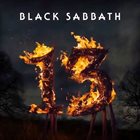 3.67
3.67 |
68 ratings

Pekka
Ok. So here it is then.
...
Phew. A lot has happened since 1978. The latest developments of the endlessly dramatic saga of Black Sabbath of course being the numerous reunion tours with the original line-up, one aborted recording project with Rick Rubin, hiatuses, other projects, more reunion tours and other projects and finally the triumphant declaration that the true original Sabbath will reunite for one last album. Well that went to hell as we all know with Bill Ward dropping out of the project for dare I say obvious reasons of not being that good anymore, and even Cancer - already not in very high regard in the Sabbath camp for what he did to Ronnie J. - tried to fuck with the proceedings. But Tony Iommi the Iron Man wouldn't have that and here we are.
If not the original Sabbath, then at least the Ozzy Sabbath is back again, and all things considered I say that's good enough. Personally I didn't dare expect much anything despite the fact, or, to be fair, my opinion that whatever Tony Iommi has put out in recent years, be it Heaven & Hell or solo projects, has been of very high quality. The man just doesn't run out of riffs and Geezer's still got his fingers working. But whatever new Ozzy I've heard lately has been extremely uninspired, but to be fair he still has sounded like he always did, though maybe a tad auto-tuned. So all the individual ingredients are basically there, but how does the Rubin factor alter the picture and what about the other B. W.? (I like to believe his initials and the number of letters in his name, along with his much more impressive work record, had some contribution in Rubin's insistence they use him instead of Tommy Clufetos). Does it feel like the real thing anymore?
Turns out Rubin chose the same approach as he did in saving his previous metal mammoth from trying new stuff; go back to the beginning, how did you do things then, try to get in the same mind set, etc. And so the first track, End of the Beginning, plays as an updated version of the song Black Sabbath. Very samey slow ominous onslaught of murky chords, first crashing in heavily, then the verse takes it down and then back up with full force, eventually fading into silence and then a change of tempo into a more furious riff. It all sound very, very familiar, even troublingly so. But soon after the song continues into greener pastures, all very vintage Sab but with new ideas. The first track is like a microcosm of the entire album; at times it sounds like it's been done before, at times it sounds like new stuff done in the good old BS way, but damn, the familiar parts sound way too good as well.
So you can bicker about N.I.B.2. or The Continuing Journey of Planet Caravan or then again you can just revel in the fact that the grandfathers of metal can still pound it with the best of them, and if they've been doing it for 40 years and counting, it's easy to forgive if something's perhaps been tried before. Because they really are some pretty wonderful tunes. You can pretty much sense the effect that Rubin has had on this record, as each and every song could be placed on one of their first six albums, no outside influences whatsoever than what they drew upon back then. The only exception really is Live Forever, the riffs of which I can imagine might originally have been written with the sadly missed voice of Ronnie James Dio echoing in Iommi's head. Since the first time I pictured RJ belting out the first line "Juuuuuust befoore you diee!" I haven't gotten rid of it and can't shake the nagging thought that Ozzy's lower, less powerful register is a bit of a compromise on the song.
But other than that, not much complaining to do. My favourites from this album tend to be the most epic, heavy numbers; God is Dead?, Age of Reason, Dear Father. A special shout out has to go to the "hey all you stoner kids, we were doing this decades before you were even born, so listen up!" track Damaged Soul. Sweet, sweet stuff. And when the album comes to an end with Dear Father, the first track's opening minutes gain some perspective; while everything starts with the extremely blacksabbathian riffing mentioned before, it also closes with a very familiar riff, sort of a less dissonant version of the original trinonus opening of the title song. Very cool bookends to the album - and when the track somes to a screeching stop, of course there is the inevitable thunder and bells closing out the saga where it began. An obvious, but classy move to highlight the end of the band's recording career.
So does it still feel like the real thing?
Hell yeah. Tony Iommi just doesn't seem to run out of riffs, Geezer's bass work is just as brilliant as it always was and he still owns a nice sharp pencil to work lyrics with, Ozzy sounds like Ozzy and remarkably good at that for his age and lifestyle, whatever autotuning there is being quite subtly done. Ok, Bill is not there, but Brad does an extremely good job half emulating Ward's style and half bringing his own. The sound is semi-raw, unpolished and clear, just as it should be.
Only the test of time will tell the end results, but I'm pretty positive that we can add a seventh album to the string of Ozzy Sabbath classics. Welcome back and farewell, gentlemen!